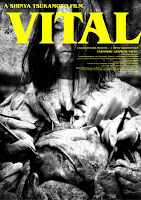
Vital (Shinya Tsukamoto, 2004)
Rating: 9.2
Tsukamoto’s film Vital could almost be interpreted as a Freudian exploration of the unconscious and conscious self that unfolds through the life of the protagonist. After getting into a car accident and suffering amnesia, Hiroshi Takagi attempts to reclaim an identity and find his “real self”, as he refers to it. Before the accident Hiroshi rebelled against his parent’s pressuring him to become a doctor, but following the accident he decides to study medicine of his own accord and goes on to excel, and even finish at the top of his class. This conflict brings into question how surroundings and social conditions influence human choices as opposed to choices made free from outside interference or apprehensions almost transcendentally or naturally. I emphasize Freudian unconscious thought because of the short scene that was within a sequence of scenes showing Hiroshi’s ascent through medical school. In the scene A professor is lecturing about the unconscious in front of a blackboard with “Freud” written on it. We next cut to Hiroshi sitting at his desk, intently listening, as the camera slowly zooms in on him conveying his interest in the subject.
In relation to unconscious thought, Hiroshi begins having fantasies about his girlfriend Ryôko, who died in the car accident, which he describes as being more than just dreams or memories. As his memory returns gradually, he realizes he is dissecting the cadaver of Ryôko in his lab. Hiroshi becomes more conflicted between the reality of confronting his dead girlfriend on a daily basis on the dissection table and meeting with her in his unconscious thoughts. On one hand his lab instructor is telling him to “trust his eyes, the truth is there to see”, while on the other he asks himself “what is my consciousness?” In one of his fantasies he tells Ryôko,“This is the real me, I’m going to stay here.” Tsukamoto helps us distinguish events from the present and this fantasy world through mis en scéne. The fantasy sequences are usually brightly lit exterior daytime locations such as the beach or jungle. Conversely, the scenes taking place during present time mostly consist of blue tinted lighting filters as well as constant rainfall, low-key lighting, and are for the most part interior night shots, until the end. After the burial of Ryôko, we see Hiroshi standing outside in what appears to be Spring weather. Birds are chirping, the sun is shining, and we see lush greenery. Next the scene cuts to Hiroshi’s point of view and the camera tilts up until we see trees against the blue skyline. Perhaps this scene represents the end of Hiroshi’s internal conflict with the rainy season over as well as medical school, and Ryôko now buried. Perhaps the setting leaves an ambiguity to his decision to move on with “reality” or seek refuge in his unconscious world.
Tsukamoto’s usually deals with invasions of the body and especially the idea that destruction breeds rebirth and Vital is no exception. Hiroshi almost becomes a new person after the fatal accident and Ryôko becomes reborn in his mind as well. He literally invades his girlfriend’s body through dissection in order to reclaim his past while also forging a new identity. However, the director chooses to show us Hiroshi’s artistic renderings of Ryôko’s organs more rather than exposing her insides which is another way he separates “reality” and the perception of reality. More importantly, I think Tsukamoto is addressing the infringement of society into our individual choices. People are deprived of complete clarity and freedom from outside pressures and Tsukamoto perhaps is saying that we each have “real self” and natural fate that is redirected and/or never fulfilled.
No comments:
Post a Comment